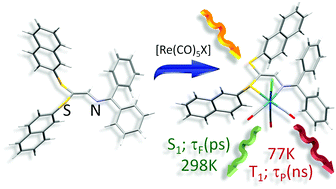2-Azabutadiene complexes of rhenium(i): S,N-chelated species with photophysical properties heavily governed by the ligand hidden traits†‡
Abstract
The reaction of [Re(CO)3(THF)(μ-Br)]2 or [Re(CO)5X] (X = Cl, Br, I) with the diaryl-2-azabutadienes [(RS)2C![[double bond, length as m-dash]](https://www.rsc.org/images/entities/char_e001.gif) C(H)–N
C(H)–N![[double bond, length as m-dash]](https://www.rsc.org/images/entities/char_e001.gif) CAr2] containing two thioether arms at the 4,4-position forms the luminescent S,N-chelate complexes fac-[(OC)3ReX{(RS)2C
CAr2] containing two thioether arms at the 4,4-position forms the luminescent S,N-chelate complexes fac-[(OC)3ReX{(RS)2C![[double bond, length as m-dash]](https://www.rsc.org/images/entities/char_e001.gif) C(H)–N
C(H)–N![[double bond, length as m-dash]](https://www.rsc.org/images/entities/char_e001.gif) CAr2}] (1a–h). The halide abstraction by silver triflate converts [(OC)3ReCl{(PhS)2C
CAr2}] (1a–h). The halide abstraction by silver triflate converts [(OC)3ReCl{(PhS)2C![[double bond, length as m-dash]](https://www.rsc.org/images/entities/char_e001.gif) C(H)–N
C(H)–N![[double bond, length as m-dash]](https://www.rsc.org/images/entities/char_e001.gif) CPh2}] (1c) to [(OC)3Re(OS(
CPh2}] (1c) to [(OC)3Re(OS(![[double bond, length as m-dash]](https://www.rsc.org/images/entities/char_e001.gif) O)2CF3){(PhS)2C
O)2CF3){(PhS)2C![[double bond, length as m-dash]](https://www.rsc.org/images/entities/char_e001.gif) C(H)–N
C(H)–N![[double bond, length as m-dash]](https://www.rsc.org/images/entities/char_e001.gif) CPh2}] (1j) bearing a covalently bound triflate ligand. The cyclic voltammograms reveal reversible S^N ligand-centred reduction and irreversible oxidation waves for all complexes. The crystal structures of nine octahedral complexes have been determined along with that of (NaphtylS)2C
CPh2}] (1j) bearing a covalently bound triflate ligand. The cyclic voltammograms reveal reversible S^N ligand-centred reduction and irreversible oxidation waves for all complexes. The crystal structures of nine octahedral complexes have been determined along with that of (NaphtylS)2C![[double bond, length as m-dash]](https://www.rsc.org/images/entities/char_e001.gif) C(H)–N
C(H)–N![[double bond, length as m-dash]](https://www.rsc.org/images/entities/char_e001.gif) CPh2 (L6). A rich system of weak non-covalent intermolecular secondary interactions through CH⋯X(Cl, Br)Re, CH⋯O, CO⋯π(Ph), CH⋯πCO, CH⋯O and CH⋯S contacts has been evidenced. The photophysical properties have been investigated by steady-state and time-resolved absorption (fs transient absorption, fs-TAS) and emission (ns-TCSPC and ps-Streak camera) spectroscopy in 2-MeTHF solution at 298 and 77 K. The emission bands are composed of either singlet (450 < λmax < 535 nm) and/or triplet emissions (at 77 K only, λmax < 640 nm, or appearing as a tail at λ > 600 nm), which decay in a multiexponential manner for the fluorescence (short ps (i.e. <IRF) < τF < 1.9 ns at 298 and 77 K) and monoexponentially for the phosphorescence (4.0 < τP < 7.0 ns at 77 K). The fs-TAS data reveal the presence of 2 to 4 transient species decaying in four narrow time windows (generally 125–165 fs, 370–685 fs, 3–6 ps, 30–45 ps). The complexity of these kinetics was explained by studying the photophysical behaviour of ligand L6. Its behaviour is the same as the complexes thus indicating that the ligand dictates the kinetic traits of the Re-species, except for the triplet emission as L6 is not phosphorescent. The triplet lifetime (4.0 < τP < 7.0 ns) is considered very short but not unprecedented. Furthermore, the nature of the lowest energy excited states of these chelate compounds and L6 has been addressed using DFT and TDDFT calculations and been assigned to metal-to-ligand (MLCT) and/or intraligand charge-transfer (ILCT).
CPh2 (L6). A rich system of weak non-covalent intermolecular secondary interactions through CH⋯X(Cl, Br)Re, CH⋯O, CO⋯π(Ph), CH⋯πCO, CH⋯O and CH⋯S contacts has been evidenced. The photophysical properties have been investigated by steady-state and time-resolved absorption (fs transient absorption, fs-TAS) and emission (ns-TCSPC and ps-Streak camera) spectroscopy in 2-MeTHF solution at 298 and 77 K. The emission bands are composed of either singlet (450 < λmax < 535 nm) and/or triplet emissions (at 77 K only, λmax < 640 nm, or appearing as a tail at λ > 600 nm), which decay in a multiexponential manner for the fluorescence (short ps (i.e. <IRF) < τF < 1.9 ns at 298 and 77 K) and monoexponentially for the phosphorescence (4.0 < τP < 7.0 ns at 77 K). The fs-TAS data reveal the presence of 2 to 4 transient species decaying in four narrow time windows (generally 125–165 fs, 370–685 fs, 3–6 ps, 30–45 ps). The complexity of these kinetics was explained by studying the photophysical behaviour of ligand L6. Its behaviour is the same as the complexes thus indicating that the ligand dictates the kinetic traits of the Re-species, except for the triplet emission as L6 is not phosphorescent. The triplet lifetime (4.0 < τP < 7.0 ns) is considered very short but not unprecedented. Furthermore, the nature of the lowest energy excited states of these chelate compounds and L6 has been addressed using DFT and TDDFT calculations and been assigned to metal-to-ligand (MLCT) and/or intraligand charge-transfer (ILCT).



 Please wait while we load your content...
Please wait while we load your content...